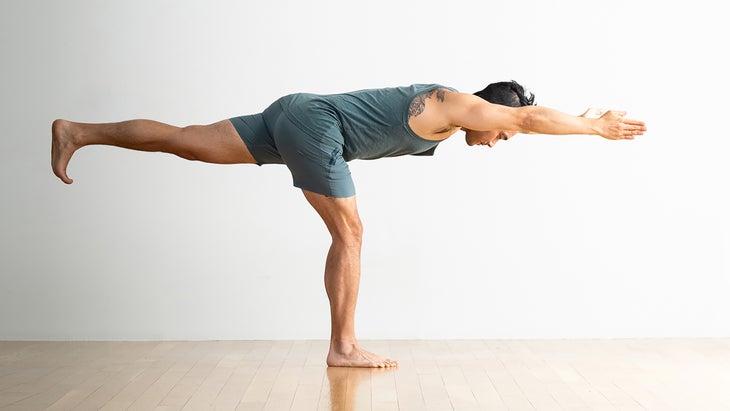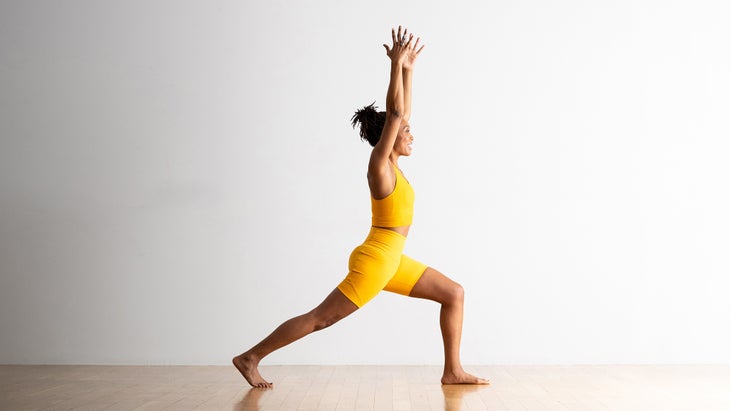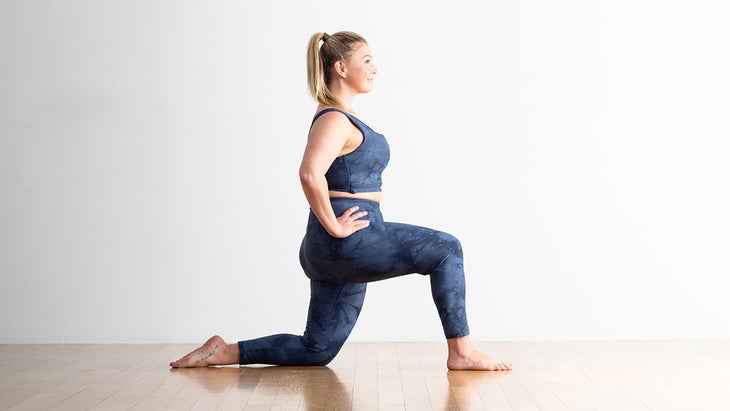“], “filter”: { “nextExceptions”: “img, blockquote, div”, “nextContainsExceptions”: “img, blockquote, a.btn, a.o-button”} }”>
Your knees are complex—and incredibly important. In addition to holding you upright and carrying you through the world, your knees also help absorb the shock from everyday movements like walking, running, jumping, or moving from pose-to-pose in your yoga practice. As such, taking care of your knees is critical. If you’re experiencing pain in these crucial joints, it’s important to work on strengthening the muscles around your knees, including your hamstrings, quadriceps, abductors, adductors, and calves. I reached out to Heather Otterbine, owner of OmBodies Yoga in Mt. Pleasant, Michigan, to get her recommendations on the best yoga poses for knee pain.
What should you keep in mind when practicing yoga with knee pain?
First, remember: Everyone’s body is different. Depending on the extent of your knee pain, these poses may or may not be beneficial to you. If you’re attending an in-person class, Otterbine recommends arriving at the studio a few minutes early to alert the teacher of your pain, so they can suggest variations throughout the practice.
For those who prefer to practice online, Otterbine recommends doing research on the right modifications for your body. You can also opt to reach out to a medical professional to find out what you need to keep in mind for your home practice. When practicing with knee pain—or any pain, for that matter—it’s critical to listen to your body and only do what feels good for you.
You also may want to have some props on hand. When practicing, Otterbine says you may want to pad your knee with a blanket—or choose not to practice certain poses, such as One-Legged King Pigeon Pose, which put pressure on the joint.
5 yoga poses for knee pain
Uttanasana (Standing Forward Bend With Ankles Crossed)
By crossing your ankles in Standing Forward Bend, you’re able to stretch those (very) tight IT bands, which play a critical role in stabilizing your knees, Otterbine says. “If [the IT band] gets too tight, it can kind of pull the knee out of alignment,” she says. When practicing this pose, she says you can bring your hands to blocks or the back of a nearby chair. You can also opt to bend or straighten your knees as much as it feels comfortable to you.

Virabhadrasana III (Warrior III With a Bent Standing Leg)
This pose can help strengthen the abductors on the outside of your hip, gluteus medius, and gluteus minimus, Otterbine says. These abductors play a key role in strengthening your knees. If the abductors are weak, Otterbine says it will allow your knee to collapse in—something you want to avoid. Additionally, by bending the standing knee in this balancing posture, you’re working to stabilize your pelvis and strengthen the muscles around your pelvis and knee, she says.

Upavistha Konasana (Wide-Angled Seated Forward Bend)
Otterbine says it’s crucial to stretch the adductors of your inner thighs, in order to support the health of your knees (and all of your leg joints). If these muscles get tight, they’ll pull the knee inward, which is something you want to avoid. You can sit straight up in this pose with your fingers on the ground (as pictured), or walk your hands forward any amount to feel a deeper stretch. Not a fan of the Wide-Angled Seated Forward Bend? Otterbine says Malasana (Garland Pose) can provide similar benefits.

High Lunge With Arms Extended Forward
Come into a High Lunge (as shown above), and then tilt your chest 45 degrees forward (on a diagonal line). This variation of High Lunge works on strengthening your quadriceps, a key factor in practicing yoga for knee pain, Otterbine says. If your quadriceps are weak, it can hurt the functionality of your knees, she says.

Anjaneyasana (Low Lunge)
In addition to strengthening your quadriceps, Otterbine says it’s important to spend time stretching them, as well. She recommends practicing a Low Lunge, which can loosen up tight quadriceps. In a similar way to the adductors of your inner thighs, tight quadriceps can pull on your knee joints, potentially leading to damage, she says. You can also opt to stretch them through a modified Bridge Pose with a bolster or block under your sacrum, she says.

